Confession time: winter isn’t exactly everyone’s favorite season. The endless stretch of grey skies, shorter days, and the ever-present threat of a sky-high heating bill can certainly dampen spirits. For many, the only saving grace during these chilly months comes in the form of vibrant, indoor plants. These green companions have a unique way of making the world a little brighter, offering a tangible connection to nature and a comforting reminder that spring is, indeed, just around the corner.
And no, we’re not talking about high-maintenance divas that demand constant attention, precise watering schedules, or an exact amount of sunlight. This article focuses on resilient, low-maintenance plants that not only look fantastic but also thrive in cooler indoor environments. These botanical heroes won’t guilt-trip you for missing an occasional watering session. Plus, many of them come with the added bonus of purifying the air – a welcome feature when central heating systems often leave indoor air feeling stale and uninviting.
Whether you’re a seasoned plant parent with a sprawling indoor jungle or someone who considers themselves to have a “black thumb” (we all start somewhere!), this comprehensive guide offers something for everyone. So, grab a warm blanket, prepare your favorite hot drink, and get ready to discover the best indoor plants that will not only survive but truly flourish with you this winter. Your living space is about to experience a significant, verdant glow-up! ✨🌱✨
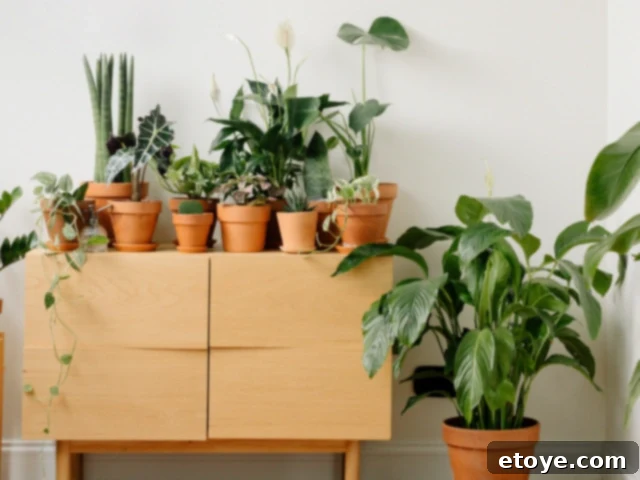
How Indoor Plants Revolutionize Your Winter Living
Beyond the chilly temperatures and diminished daylight, winter often brings a range of challenges that can impact our mood, the quality of our indoor air, and the overall ambiance of our homes. This is precisely where indoor houseplants step in as the ultimate winter pick-me-up. Let’s explore the powerful ways they help you conquer the winter blues and create a more comfortable, inviting environment.
They Elevate Your Mood and Mental Well-being
It’s widely accepted that plants bring a sense of joy and tranquility. Scientific research strongly supports this notion. For instance, one notable study demonstrated that individuals who spent just five to ten minutes in a room adorned with a few houseplants reported feeling noticeably happier and more relaxed compared to those in a plant-free environment. Further studies have consistently shown that spending time in the vicinity of plants contributes to increased self-esteem, reduced stress levels, and greater life satisfaction. During the gloomy winter months, this biophilic connection can be particularly vital for maintaining positive mental health.
They Naturally Purify and Freshen Your Indoor Air
Winter often means we spend more time indoors, breathing in recirculated, heated air that can feel stale and contribute to the buildup of indoor air pollutants. This is where plants become essential allies. Species like the Rubber Plant, Snake Plant, and Pothos are renowned for their natural air-purifying capabilities. They actively absorb common household toxins such as formaldehyde, benzene, and trichloroethylene from the air, effectively improving indoor air quality and lending your living space a noticeably fresher feel. Investing in these plants means investing in cleaner air for you and your family.
They Combat Dry Air Caused by Central Heating
If the dry air from your central heating system leaves your skin feeling parched and your sinuses irritated, certain plants can come to the rescue. Plants with larger leaves, such as the Chinese Evergreen or Rubber Plant, are excellent at releasing moisture into the air through a process called transpiration, thereby helping to boost relative humidity levels in your home. For an even greater humidifying effect, consider grouping several plants together in a room. You can also place them on humidity trays filled with pebbles and water, allowing the evaporating water to increase moisture around the plants without overwatering them.
They Infuse Life, Color, and Vibrancy Into Your Space
There’s truly nothing quite like the sight of a lush, vibrant green plant to instantly transform an indoor living space, making it feel warm, inviting, and alive. Plants introduce organic textures, varied hues, and dynamic growth that artificial decor simply cannot replicate. Even a single well-placed plant can become a focal point, drawing the eye and creating a sense of calm. If maintaining an indoor jungle were a feasible full-time occupation, many of us would happily embrace it! These living accents combat the starkness that winter can bring, adding essential character and warmth to your home.
And now, without further ado, let’s delve into…
The Top 10 Resilient Indoor Plants to Brighten Your Home this Winter
1. Snake Plant (Sansevieria trifasciata)
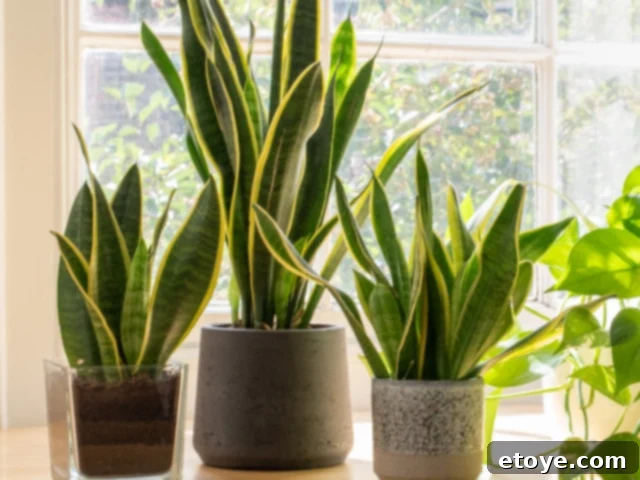
Often affectionately nicknamed “mother-in-law’s tongue,” the Snake Plant is legendary for its near-indestructible nature, making it an ideal companion for the winter months. Its striking, sword-like leaves stand upright, creating a modern, architectural statement in any indoor space. This plant boasts remarkable tolerance for low light conditions and dry air, and it practically thrives on neglect, requiring minimal watering. Furthermore, it’s celebrated for its air-purifying abilities, efficiently removing toxins from your home, even releasing oxygen at night.
Winter Care Tips: Place your Snake Plant in indirect light, or even in surprisingly low light levels—it will adapt beautifully. The key to its winter survival is conservative watering; allow the soil to completely dry out between watering sessions, sometimes for weeks at a time. Overwatering is the quickest way to kill this resilient plant. Its sleek, glossy green leaves, sometimes variegated with yellow or silver, add a touch of sophisticated greenery to your winter decor.
2. Pothos (Epipremnum aureum)

If there were a popularity contest for houseplants, the Pothos would undoubtedly wear the crown. Known colloquially as “Devil’s Ivy” (an ironic moniker given its angelic ease of care), Pothos is incredibly versatile, forgiving, and endlessly stylish. It comes in a stunning array of varieties: ‘Golden Pothos’ with its characteristic marbled yellow streaks, ‘Neon Pothos’ boasting bright lime-green foliage, and ‘Marble Queen Pothos’ adorned with creamy white variegation, to name just a few. This plant grows vigorously, adapts well to both soil and water environments, and impressively bounces back from a wide range of common plant care missteps. Its exceptional resilience makes it a perfect recommendation for anyone new to the world of houseplants, especially for surviving the indoor challenges of winter.
Winter Care Tips: Pothos thrives in indirect sunlight but can also tolerate lower light levels with remarkable grace. It’s not particularly fussy about watering; simply allow the soil to dry out almost completely between waterings, reducing frequency during the colder, darker months. Its trailing vines look absolutely stunning cascading from shelves, gracing tabletops, or elegantly draping from hanging baskets, adding a touch of vibrant life to any winter interior.
3. Jade Plant (Crassula ovata)

The Jade Plant is arguably one of the most endearing and recognizable succulents, making it an excellent choice for individuals prone to forgetting their watering duties. Its distinctive round, thick, and glossy leaves are not just aesthetically pleasing; they are master reservoirs, storing water efficiently. This unique adaptation allows the Jade Plant to comfortably survive long periods without water, making infrequent watering during the colder, dormant months perfectly acceptable. Its tree-like appearance and slow growth can even give it the look of a miniature bonsai, adding a touch of timeless elegance to your home.
Winter Care Tips: For optimal health, position your Jade Plant in a spot that receives bright, natural light – a sunny windowsill is often its preferred location. During winter, significantly reduce your watering frequency; only water when the soil has completely dried out. Be cautious of overwatering, as this can lead to root rot. This succulent’s hardy nature ensures it remains a vibrant green focal point throughout the chilliest days.
4. ZZ Plant (Zamioculcas zamiifolia)
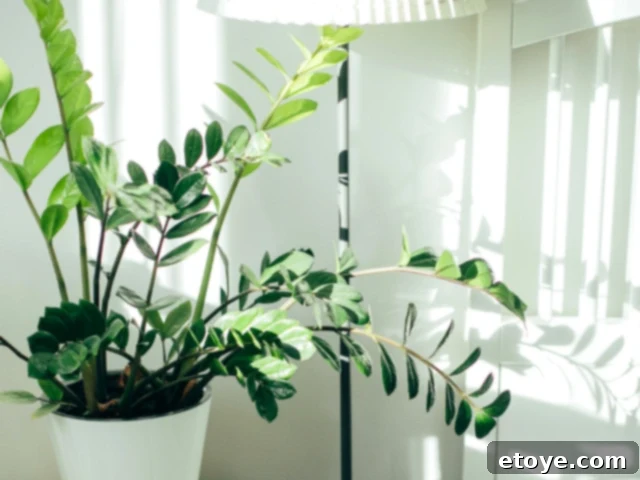
If you’ve ever claimed to have a “black thumb,” allow us to introduce you to the ZZ Plant, the undisputed MVP of low-maintenance houseplants. This remarkable plant possesses an uncanny ability to thrive on neglect, making it one of the absolute easiest plants to care for, particularly during the challenging winter season. Its thick, waxy leaves and unique rhizomatous root system allow it to store water efficiently, enabling it to withstand prolonged periods of drought. The ZZ Plant brings a striking, almost sculptural aesthetic to any room, with its upright stems and dark green, glossy foliage.
Winter Care Tips: The ZZ Plant is perfectly suited for low-light conditions, though it certainly won’t object to a spot with indirect sunlight. The most critical winter care tip is to water sparingly. In the colder months, its metabolic processes slow down significantly, meaning it needs very little moisture. Aim to water roughly once every 3-4 weeks, or even just once a month when temperatures are consistently cool. Always ensure the soil is thoroughly dry before rewatering to prevent root issues.
5. Christmas Cactus (Schlumbergera bridgesii)
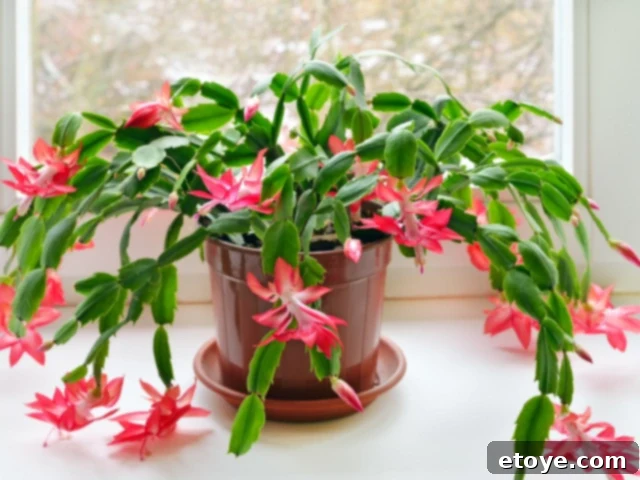
With a name like Christmas Cactus, it’s almost impossible not to want to welcome this delightful plant into your home for the winter. What makes it truly special are its vibrant, tubular blooms that typically emerge during the late fall and winter months, bringing much-needed color and cheer to an otherwise dreary season. Unlike many tropical plants, the Christmas Cactus actually enjoys cooler temperatures and a brief period of reduced watering before flowering, making it perfectly adapted to winter conditions. Its ease of maintenance and stunning seasonal display often lead to these plants being treasured and passed down through generations.
Winter Care Tips: This plant thrives in bright, indirect light. During its blooming period, consistent moisture is appreciated, but always ensure it’s planted in well-draining soil to prevent waterlogging. Water when the top inch or two of soil feels dry to the touch, but avoid letting it sit in standing water, as this can lead to root rot and attract unwanted fungus gnats. After flowering, reduce watering slightly to allow it a short rest period before new growth emerges.
6. Aloe Vera (Aloe barbadensis miller)

The versatile Aloe Vera plant performs double duty in your home, serving as both attractive decor and a handy first-aid kit. Its thick, fleshy leaves store a soothing gel that has been used for centuries to treat minor burns, cuts, and, yes, even dry, chapped skin exacerbated by cold winter weather. Simply snap off a small leaf, squeeze out the clear sap, and apply for instant, natural moisture. As a succulent, Aloe Vera thrives with less light and is incredibly forgiving if you happen to forget it exists for a week or two, making it perfect for busy winter schedules.
Winter Care Tips: This ideal indoor plant flourishes in bright, indirect sunlight. During the colder months, reduce watering frequency significantly, typically every 2-3 weeks. Always perform the “finger test” before watering: insert your finger about an inch into the soil to ensure it’s completely dry. Overwatering is a common mistake that can lead to root rot. Its distinctive rosette form and spiky leaves add a unique texture to your plant collection.
7. Rubber Plant (Ficus elastica)

The Rubber Plant, a classic among houseplants, is celebrated for its bold, oversized, and strikingly glossy dark green leaves, which introduce a touch of sophisticated drama and tropical flair to any indoor space. Available in various cultivars, including deep burgundy and variegated forms, it offers versatility in its appearance. Beyond its aesthetic appeal, the Rubber Plant is recognized by NASA as one of the most effective houseplants for improving indoor air quality, filtering out common airborne toxins. Its inherent resilience makes it a fantastic choice for navigating the challenges of winter indoor environments.
Winter Care Tips: This elegant Ficus thrives in bright, indirect light but is remarkably adaptable and can tolerate lower light conditions, making it flexible for winter placement. Watering should be done every couple of weeks, allowing the top two inches of soil to dry out between sessions. Be wary of overwatering, which typically manifests as droopy yellow leaves. The large leaves benefit from an occasional dusting with a damp cloth; this not only keeps them looking shiny but also ensures optimal light absorption for photosynthesis, crucial during shorter winter days.
8. Spider Plant (Chlorophytum comosum)
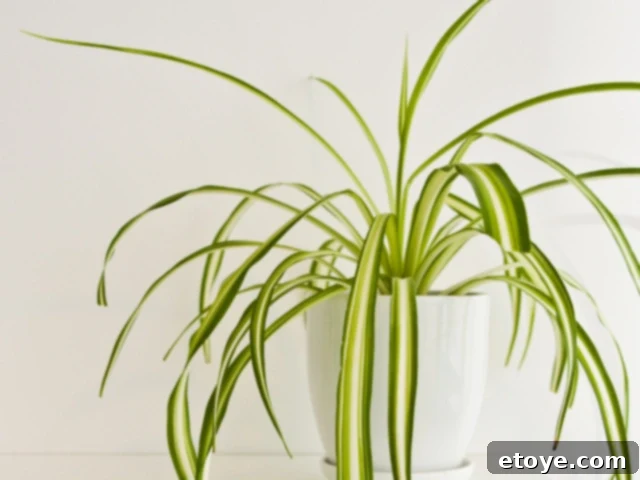
The Spider Plant is a timeless favorite and an “oldie but a goodie” for a reason. Its arching, variegated leaves and charming “spiderettes” (baby plants that dangle from the mother plant) give it a playful, dynamic appearance, making it perfect for hanging baskets or high shelves. Renowned for its exceptional air-purifying capabilities, the Spider Plant efficiently removes harmful toxins from the air, contributing to a healthier indoor environment. Its remarkable ease of care and adaptability make it one of the best indoor plants to nurture through the winter season, even for beginners.
Winter Care Tips: Place your Spider Plant in a spot that receives natural, indirect light. While it can tolerate lower light, brighter conditions will encourage more vigorous growth and the production of those delightful spiderettes. Water regularly, but never excessively; allow the top inch of soil to dry out before rewatering. Soggy roots are the enemy, so ensure proper drainage. During winter, reduce watering frequency slightly as the plant’s growth slows down.
9. Monstera Deliciosa (Swiss Cheese Plant)
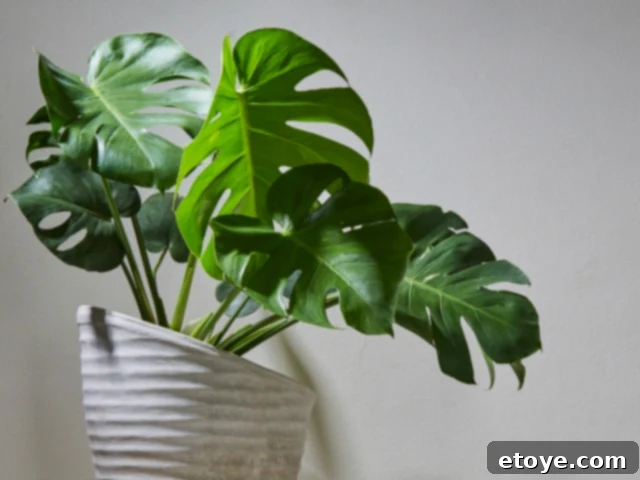
If you’re seeking a dramatic statement piece or need to fill a larger space with lush, tropical greenery, the Monstera Deliciosa, often affectionately known as the “Swiss Cheese Plant” due to its iconic fenestrated (split) leaves, is an unparalleled choice. It’s big, bold, and impossible to ignore, instantly adding a touch of jungle grandeur to any room. Despite its incredibly stylish and imposing appearance, this plant is surprisingly low-maintenance, proving its resilience even during the colder months when many plants struggle. Its unique leaf structure and ability to grow quite large make it a captivating focal point.
Winter Care Tips: Monstera thrives in bright, indirect light but can also tolerate lower light levels, making it a flexible option for winter placement. The key to its winter health is consistent, but not excessive, watering. Keep the soil consistently slightly moist, but always allow the top few inches to dry out before watering again. Never let it sit in excess water, as this can quickly lead to root rot. High humidity is a plus, so consider misting or using a pebble tray if your home is particularly dry.
10. Chinese Evergreen (Aglaonema)

The Chinese Evergreen is truly the ultimate survivor in the houseplant world. It boasts an extraordinary ability to thrive in challenging conditions, including very low light levels and dry indoor climates, making it an exceptional choice for winter. Available in a mesmerizing array of patterns and color variations—from deep greens to striking reds, pinks, and silvers—its unique foliage adds an instant tropical vibe and a splash of color to your winter home. Its hardiness and beauty ensure it remains a vibrant presence even when natural light is scarce.
Winter Care Tips: This plant is incredibly tolerant of low humidity and cold drafts, embodying the definition of a laid-back houseplant. During winter, allow the top few inches of soil to dry out completely before watering again, as its growth slows down considerably. Overwatering is the main threat. An occasional wipe down of its large leaves with a damp cloth will not only keep them looking shiny and free of dust but also enhance their ability to absorb light, which is crucial during shorter winter days.
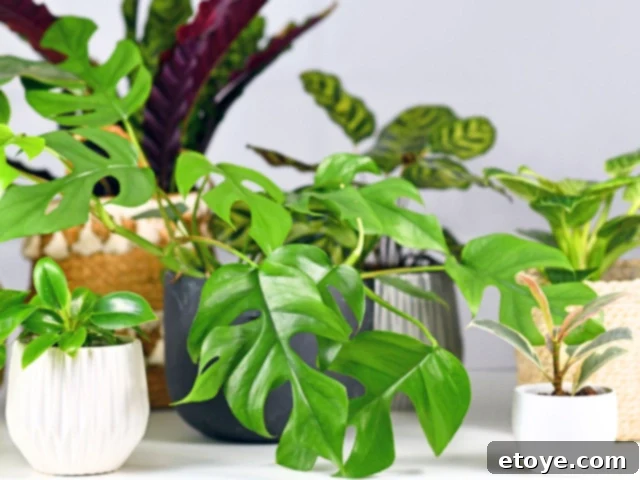
Mastering Winter Care for Your Indoor Plants
Caring for your beloved houseplants during winter requires a slightly different approach than in warmer months. With a few simple adjustments, you can ensure your leafy friends not only survive but truly thrive through the colder season. Here’s a comprehensive guide to keeping your indoor oasis flourishing:
Adjust to Lower Light Levels
As winter ushers in shorter days and weaker sunlight, even plants that adore bright light will need some adaptation. Move your plants closer to natural light sources, such as a south-facing window, to maximize their exposure. However, be vigilant about cold drafts directly from windows, which can shock sensitive plants. If your space consistently lacks sufficient indirect sunlight, consider investing in a high-quality grow light. Modern LED grow lights are energy-efficient and can provide the full spectrum of light necessary to supplement your plants’ needs, preventing legginess and promoting healthier growth.
Dial Back the Watering
This is perhaps the most crucial winter care tip. Most plants enter a semi-dormant state during winter, significantly slowing their growth and, consequently, their water consumption. Overwatering is a common winter mistake and a direct path to root rot, fungal issues, and an unwelcome infestation of fungus gnats. Always ensure your pots have adequate drainage holes. Before watering, use your finger to check the soil; it should feel dry at least an inch or two down, or even completely dry for succulents and drought-tolerant plants. Using pots with well-drained soil mixes specifically designed for houseplants will also help prevent waterlogging.
Watch for Heat Sources and Drafts
Plants are not fond of extreme temperature fluctuations. Avoid placing them directly near heat sources like radiators, heating vents, or active fireplaces, as the intense, dry heat can scorch leaves and cause rapid dehydration. Conversely, icy blasts from an open window or a poorly insulated door can cause cold shock, leading to leaf drop and stunted growth. Aim to keep your plants in a location where the temperature remains relatively stable, ideally between 65-75°F (18-24°C), which is comfortable for most common houseplants. Observe your plants for signs of stress and adjust their positions accordingly.
Increase Humidity Levels
The dry air produced by central heating systems is a major winter woe for many plants, especially those with tropical origins. If your plants start to develop crispy leaf edges, this is a clear sign of low humidity. To counteract this, consider placing a humidifier nearby to increase ambient moisture. Alternatively, you can group several plants together; as they transpire, they collectively create a microclimate with higher humidity. Pebble trays filled with water (ensuring the pot sits on pebbles, not in water) also work wonders. While misting can offer a temporary boost, it’s generally less effective than these other methods and should be done carefully to avoid water spots on glossy leaves or fostering fungal issues in plants that dislike wet foliage (e.g., African Violets, Moth Orchids).
Skip the Fertilizer
Winter is generally not the time for fertilizing your houseplants. During their dormant or semi-dormant phase, plants are in rest mode, not active growth mode. Providing nutrients when they don’t need them can lead to a buildup of salts in the soil, potentially damaging the roots. Save your plant food for the warmer weather of spring, or when you notice clear signs of new growth beginning to emerge, signaling their return to active growth.
Monitor for Pests
Dry winter air and stressed plants can sometimes make them more susceptible to pests like spider mites, mealybugs, and scale. Regularly inspect the undersides of leaves and stem joints for any signs of unwanted visitors. Early detection is key! If you spot any, isolate the affected plant and treat it with appropriate organic remedies like neem oil or insecticidal soap, following product instructions carefully.
Dust Your Leaves
Over time, dust can accumulate on the leaves of your houseplants, especially those with larger, smoother surfaces. This layer of dust can impede the plant’s ability to photosynthesize effectively, reducing its capacity to convert light into energy. Gently wipe down dusty leaves with a soft, damp cloth. This simple act not only improves the plant’s appearance but also significantly boosts its overall health, allowing it to capture more of that precious winter light.
With just a little extra tender loving care and attention to these specific winter needs, your indoor plants will flourish beautifully through the seasonal change. You’ll reap the immense benefits of a lush, vibrant green oasis, bringing natural beauty and improved well-being into your home even throughout the chilliest days.

Ready to Embrace Your New Green Companions?
Winter certainly doesn’t have to condemn your home to a state of dullness and dreariness. With these incredibly easy-to-care-for houseplants, you possess the power to transform your living space into a vibrant, lush sanctuary—or even the indoor jungle of your dreams! These green companions offer a constant source of life and beauty, providing a perfect antidote to the inevitable winter blues and enhancing your overall well-being.
So, which of these resilient plants are you most looking forward to adding to your collection this year? Do you already have some of these winter-hardy varieties thriving in your home? We absolutely love hearing about your plant journeys and discoveries, so please feel free to share your thoughts, tips, and plant picks in the comments section below! Let’s cultivate a greener, happier winter together!
